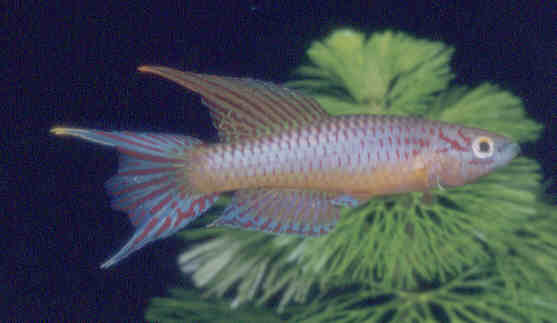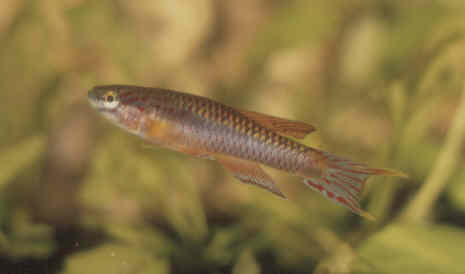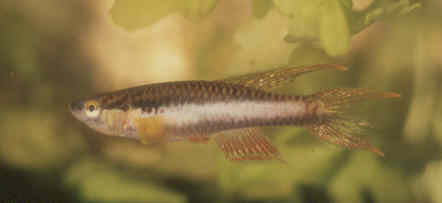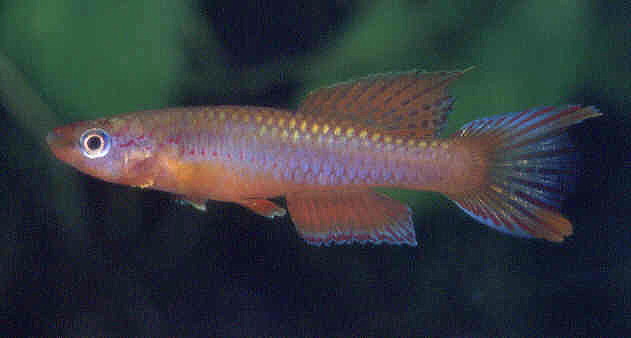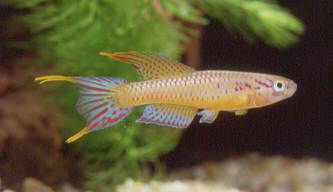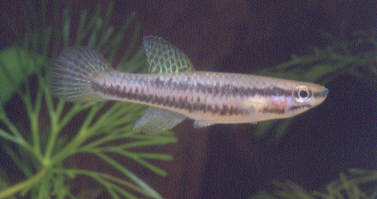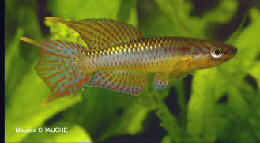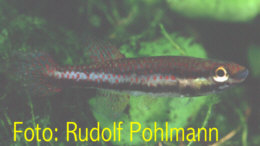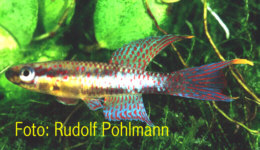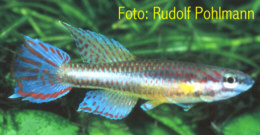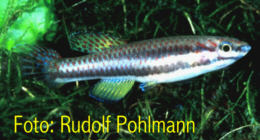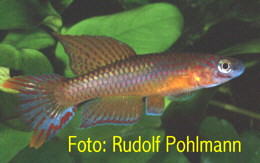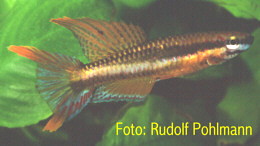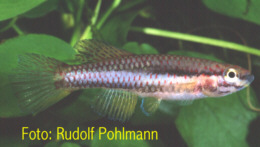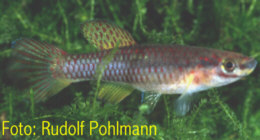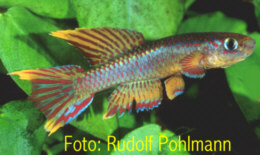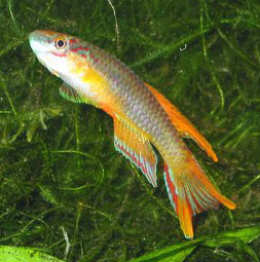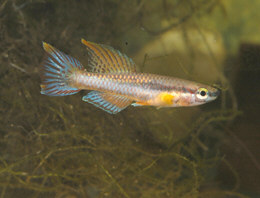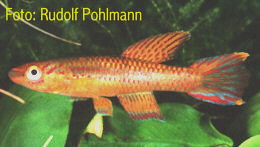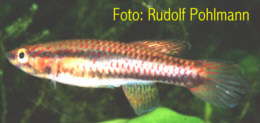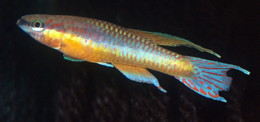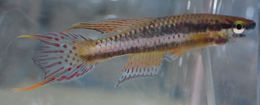Aphyosemion loennbergii (Boulenger 1903)
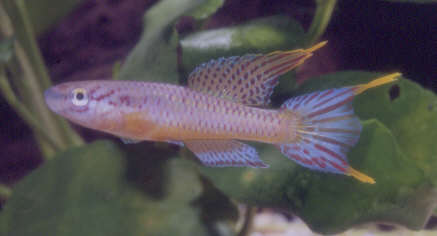
| Meaning of Name |
After Einar Lönnberg, a Swedish ichthyologist. |
||||||||||||||||||||||||
| First Description |
Boulenger 1903. Fundulus loennbergii Description of new freshwater fishes from southern Cameroon. Annals & Magazine of Natural History (7) xii, p 440-441. |
||||||||||||||||||||||||
| Size |
5 cm |
||||||||||||||||||||||||
| Meristics |
|
||||||||||||||||||||||||
| Karyotype |
n = 17, A = 25 (Scheel 1990) |
||||||||||||||||||||||||
| Sub-Genus |
Chromaphyosemion |
||||||||||||||||||||||||
| Group |
|
||||||||||||||||||||||||
| Synonyms |
|
||||||||||||||||||||||||
Populations
|
http://www.nakashima.org/ga_loenn.htm Japan Gallery CXC 31 - This population also referred
to as EY 18km CXC31. Bill Drake in BKA Newsletter No.319, April 1992
states that he received eggs in late October 1990 from Jaap Vlaming
who was a member of the collecting team who found them. |
||||||||||||||||||||||||
| Type Locality |
Types 1-2 Kribi River (now Kienke River); types 3-6 Zima Country; types 7-10 Efulen. All collected by G.L.Bates Esq. |
||||||||||||||||||||||||
| Distribution |
Southwestern Cameroon, in the Kienke, Lokundje & Nyong River drainages. The largest distribution area of the subgenus. Mainly found in low altitude areas although this species has penetrated inland in Cameroon reaching 400 m altitude & even occasionally 600 m. To the south of the Sanaga River they can be found up to the Southern Cameroon Plateau. At Lolodorf they have been found in biotopes rising up the first cliffs of this plateau. They are able to traverse difficult natural barriers such as the Sanaga River where they are found on the north bank. Also found at Mvile which is up river above the Mbikiliki falls & rapids. Perhaps the most difficult location was above the Ekom falls of the Nkam River (a drop of some 80 metres). Also found in a small river tributary of the Dibombe River situated some 30 km south southwest of Nkongsamba. This location according to Amiet 1987 is only a few tens of kms from a stream inhabited with A.riggenbachi. Known to be sympatric with A.melanogaster & A.punctulatum in the Kribi are. |
||||||||||||||||||||||||
| Habitat |
Small rainforest streams & pools flowing or situated on basement rock. In the area of Boga they are found with Aphyosemion amoenum, Epiplatys esekanus & E.sexfasciatus. At Mvilé they are found with members of the Aphyosemion cameronense group. |
||||||||||||||||||||||||
| Distinguishing Characteristics | Although members of the subgenus Chromaphyosemion can be difficult for the novice to seperate, this species according the Amiet 1987 has a 'blue caudal which is decorated with red, inter-radial stripes'. | ||||||||||||||||||||||||
| Colour/Pattern Variability | High | ||||||||||||||||||||||||
| History |
Boulenger described Fundulus loennbergii in 1903 from 2 specimens collected by Bates in the Kribi (Kienke) River, southern coastal Cameroon. In 1908 Arnold reported loennbergii which had been imported into Germany from Warri, Nigeria. These were undoubtedly misidentified. Boulenger gives the following collectors / locations in his 1915 Catalogue.
In 1915 Boulenger reported four specimens from the Zima County & a further four from Efulen, both from southern Cameroon. Boulenger also reported bivittatum from the Kribi area. In 1930 Fowler reported three male bivittatum (?) from the Kribi area. Scheel caught numerous bivittatum (?) specimens in 1966 from the area of Kribi. In the BKA newsletter No. 96, August 1973 reference is made to there only being 3 pairs in the BKA at this time. History of the synonym Fundulus pappenheimi Ahl 1924 Ahl described this sp. from a single specimen collected by Zenker at Bipindihof, Cameroon. Holly examined this individual in 1930 & changed some of the data. History of the synonym Aphyosemion (Fundulopanchax) unistrigatus Ahl 1935 Ahl described this species from 8 specimens collected at Bipindi, southern Cameroon by Zenger. This location is at an altitude of 63 metres above sea level & is within the Lokundje drainage. |
||||||||||||||||||||||||
| Breeding Notes |
Regarded in some accounts as a difficult species
to breed. Males can be aggressive & 2-3 females per male is a better
ratio. Eggs are laid generally in top mops. Water incubation takes 10-12
days. Sexual maturity takes around 6-7 months. In the BKA newsletter No.96, August 1973 a small reference is made to not touching the eggs but leaving the fish to breed in a well planted tank & let the young grow on with the parents. They were regarded in these days as not prolific. The breeder only raised 2 trios in 4 months. In BKA newsletter No.106, June 1974 reference
is made to eggs being slightly larger than bivittatum
& requiring an incubation period of 20 days at 21-22°C. Fry
were reported to be large on hatching & able to take newly hatched
brine shrimp although it was felt better to feed infusoria as a first
food. Oliver Legros in BKA newsletter No.327, December
1992 states that they are 'one of the easiest species to breed'. He
reported that some eggs have been observed to stay clear in a diapausal
state where these fry can take up to a month to hatch. Fry emerge normal
& healthy. |
||||||||||||||||||||||||
| Diameter of Egg | |||||||||||||||||||||||||
| Remarks |
|
A.loennbergii Pouma. Photo courtesy of Ed Pürzl
